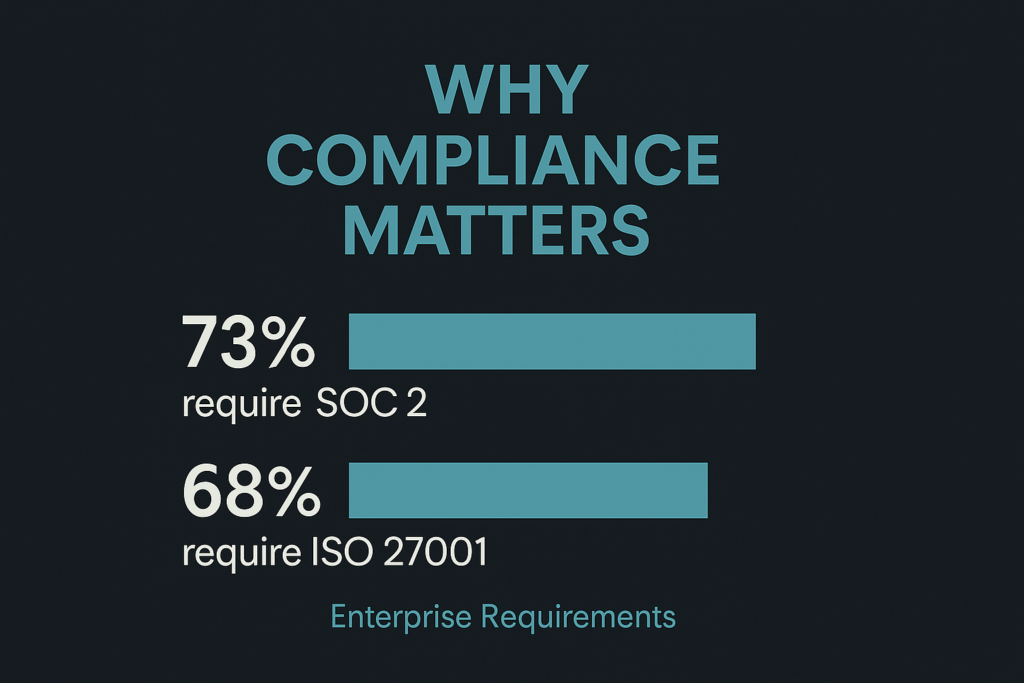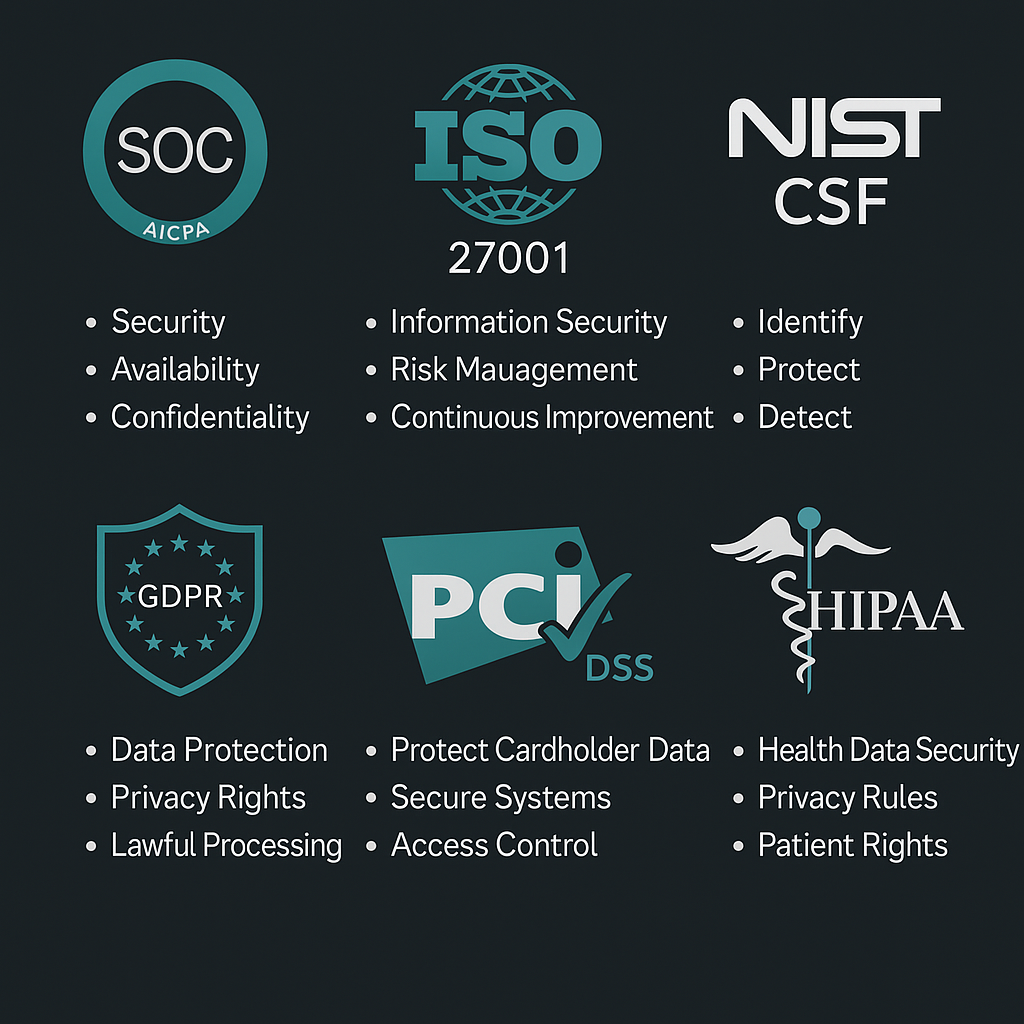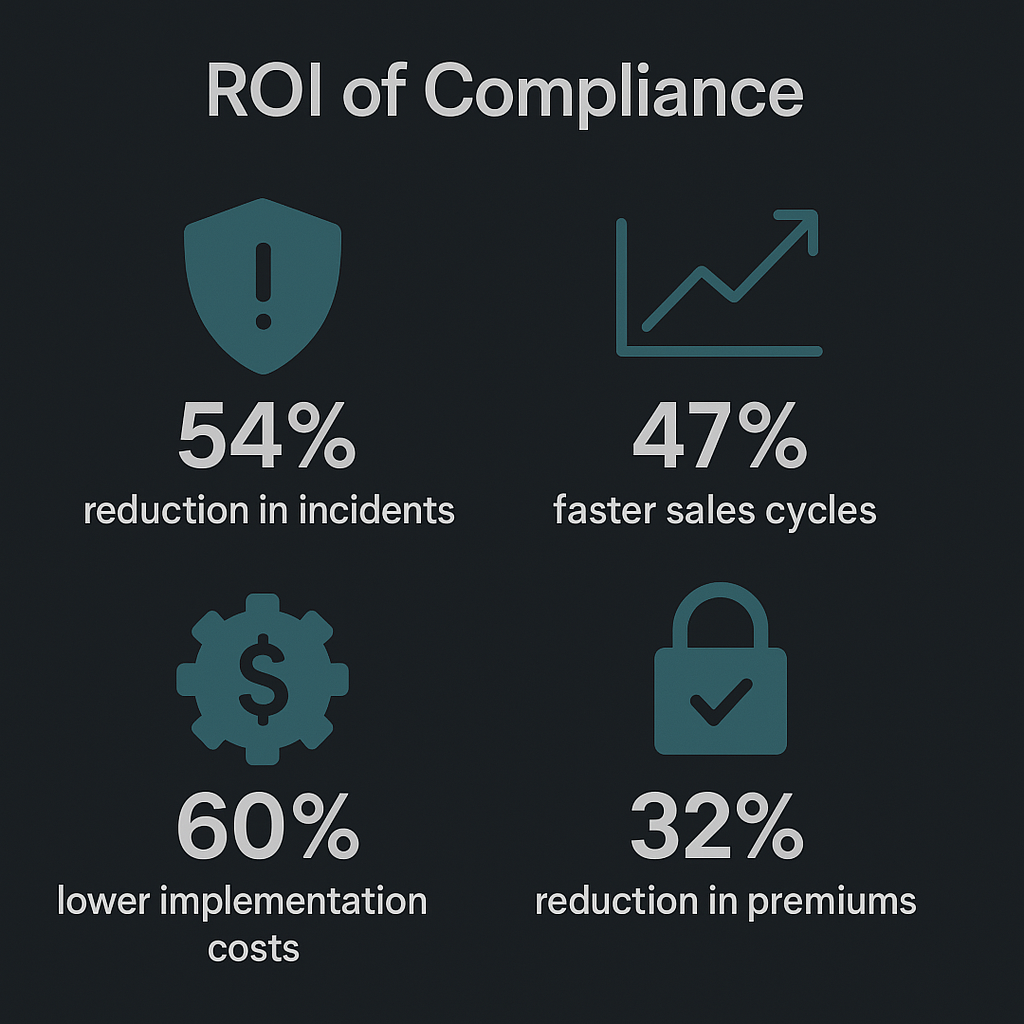In today’s digital landscape, compliance frameworks aren’t just for enterprise organizations – it’s becoming essential for businesses of all sizes. Understanding which frameworks apply to your organization and implementing them effectively can seem overwhelming, especially for small and medium-sized businesses just beginning their compliance journey.
Key Notes
- Compliance frameworks provide structured approaches to managing security, privacy, and other regulatory requirements
- Early adoption of compliance principles creates a competitive advantage and builds customer trust
- Implementation can be phased, starting with framework alignment before pursuing formal certification
- The right preparation significantly reduces costs and complexity of compliance initiatives
Why Compliance Matters for Growing Businesses
Many startups and SMBs mistakenly believe compliance is only relevant for large enterprises with extensive resources. However, adopting compliance frameworks early offers several strategic advantages:
- Customer Acquisition: Many enterprise clients require vendors to demonstrate compliance with frameworks like SOC 2 or ISO 27001 before signing contacts
- Investor Confidence: Compliance maturity signals to investors that your business takes risks seriously
- Security Foundation: Frameworks provide a structured approach to building secure practices from the ground up
- Resource Efficiency: Implementing controls during your growth phase is significantly less expensive than retrofitting them later
- Competitive Edge: Being compliance-ready differentiates your business from competitors who haven’t prioritized these standards
A recent study found that 73% of enterprises now require SOC 2 compliance from their vendors, while 68% list ISO 27001 as a procurement requirement. For growing businesses, this represents both a challenge and an opportunity to access larger markets.

Understanding Major Compliance Frameworks
SOC 2
What it is: Developed by the American Institute of CPAs (AICPA), SOC 2 focuses on managing customer data based on five “trust service criteria”: availability, processing integrity, confidentiality, and privacy.
Best for: Service providers storing data in the cloud, SaaS companies, and organizations handling sensitive information.
Key components:
- Control environment assessment
- Communication and information systems
- Risk assessment processes
- Monitoring activities
- Existing control activities
NIST CSF (Cybersecurity Framework)
What it is: Created by the National Institute of Standards and Technology, this framework provides a policy framework of computer security guidance for private sector organizations.
Best for: Organizations looking for flexible guidance that scales with their security capabilities.
Key components:
- Identify: Asset management, risk assessment
- Protect: Access control, awareness training
- Detect: Continuous monitoring, detection processes
- Respond: Response planning, communications
- Recover: Recovery planning, improvements
ISO 27001
What it is: An internationally recognized standard for information security management systems (ISMS).
Best for: Organizations seeking international recognition of their security practices and those doing business globally.
Key components:
- Systematic approach to managing sensitive information
- Comprehensive risk assessment
- Implementation of 114 controls across 14 domains
- Documented policies and procedures
- Continual improvement process
GDPR (General Data Protection Regulation)
What it is: European Union regulation on data protection and privacy that applies to any organization handling EU citizen’s data.
Best for: Any business with European customers or processing EU citizen data.
Key components:
- Data protection principles
- Lawful basis for processing
- Privacy rights for individuals
- Breach notification requirements
- Data protection impact assessments
HIPAA (Health Insurance Portability and Accountability Act)
What it is: U.S. regulation that sets standards for protecting sensitive patient health information.
Best for: Healthcare organizations and any business handling protected health information (PHI).
Key components:
- Privacy Rule: Protection of patient information
- Security Rule: Safeguards for electronic PHI
- Breach Notification Rule: Requirements for data breach reporting
- Technical, Physical, and Administrative safeguards
PCI DSS (Payment Card Industry Data Security Standard)
What it is: Security standard for organizations that handle credit card transactions.
Best for: Any business accepting credit card payments.
Key components:
- Secure network architecture
- Cardholder data protection
- Vulnerability management
- Access control measures
- Regular testing of security systems
- Documented information security policy

The Compliance Journey: Where to Start
For growing businesses, compliance can seem like a mountain to climb. Here’s a pragmatic, phased approach:
Phase 1: Framework Selection and Gap Analysis
Begin by identifying which frameworks apply to your business based on:
- Industry requirements
- Customer expectations
- Types of data you handle
- Geographic footprint
Next, conduct a gap analysis to identify the difference between your current security posture and compliance requirements. This creates a roadmap for implementation without overwhelming your team.
Phase 2: Documentation and Policy Development
Develop the foundational policies and procedures required by your chosen frameworks. These typically include:
- Information Security Policy
- Access Control Policy
- Data Classification Policy
- Incident Response Procedures
- Business Continuity Planning
- Acceptable Use Policy
Well-crafted policies establish the governance structure necessary for successful compliance
Phase 3: Control Implementation
Based on your gap analysis, prioritize control implementation by:
- Addressing high-risk gaps first
- Implementing controls that satisfy multiple framework simultaneously
- Focusing on “quick wins” that demonstrate progress
Common controls across frameworks include:
- Multi-factor authentication
- Encryption of sensitive data
- Regular security awareness training
- Access reviews
- Vulnerability Management
- Security incident response process
Phase 4: Monitoring and Measurement
Establish processes to continuously monitor your compliance posture:
- Regular internal audits
- Automated compliance monitoring
- Security awareness metrics
- Incident response testing
- Vendor risk assessments
These activities demonstrate the effectiveness of your program and prepare you for formal assessment.
Phase 5: Formal Assessment or Certification
When you’re ready, engage with qualified assessors for formal certification or attestation:
- SOC 2: Work with a licensed CPA firm
- ISO 27001: Engage an accredited certification body
- NIST CSF: Consider third-party assessment
- PCI DSS: Undergo assessment appropriate to your merchant level
Common Compliance Pitfalls and How to Avoid Them
Many organizations stumble in similar ways when pursuing compliance
- Treating Compliance as a One-Time Project
- Better Approach: Establish compliance as an ongoing program with dedicated resources and regular reviews
- Documentation without Implementation
- Better Approach: Ensure policies reflect actual practices; implementing controls before documenting them
- Siloed Compliance Efforts
- Better Approach: Build a cross-functional team including IT, security, legal, and business units
- Attempting to Boil the Ocean
- Better Approach: Phase your implementation based on risk; focus on alignment before certification
- Over-Relying on Technology
- Better Approach: Balance technology with appropriate processes and people components
Cost-Effective Compliance Strategies
For resource-constrained organizations, consider these strategies:
- Framework Harmonization: Map overlapping requirements across multiple frameworks to satisfy several with the same controls
- Risk-Based Scoping: Limit your initial compliance scope to critical systems and data
- Cloud Service Providers: Leverage compliance capabilities of major cloud platforms that often satisfy numerous requirements
- Compliance Automation: Implement tools that continuously monitor compliance posture and provide evidence
- Consultant Partnerships: Engage with specialists for specific phases rather than full implementation
Building a Compliance Culture
Successful compliance ultimately depends on organizational culture:
- Executive Sponsorship: Securing leadership buy-in communicates the importance of compliance
- Embed in Daily Operations: Integrate compliance activities into normal business processes
- Training and Awareness: Ensure all staff understand their roles in maintaining compliance
- Celebrate Success: Recognize compliance achievements as business milestones
- Continuous Improvement: Establish feedback loops to constantly enhance your program
The ROI of Proactive Compliance
Organizations that approach compliance strategically see significant returns:
- 54% reduction in security incidents after implementing framework controls
- 47% faster sales cycles when compliance certifications are in place
- 60% lower implementation costs when begun early in company growth
- 32% reduction in insurance premiums with demonstrated compliance programs
The message is clear: early, thoughtful compliance investment pays dividends in business growth, risk reduction, and operational efficiency.

How Omni Threat Solutions Can Help
At Omni Threat Solutions, we specialize in helping growing businesses develop and implement compliance programs that fit their unique needs. Our services include:
- Framework selection guidance based on your business model
- Comprehensive gap assessments to identify priorities
- Policy and procedure development aligned with framework requirements
- Control implementation assistance
- Pre-audit preparation to ensure readiness
Most importantly, we focus on establishing compliance foundations before formal audits begin, saving you significant time and expense. Our approach emphasizes practical, business-focused compliance that enables growth rather than restricting it.
Taking the Next Step
Regardless of your organization’s size or maturity, the time to start thinking about compliance is now. Begin by:
- Identifying which frameworks align with your business and customer needs
- Conducting an honest assessment of your current security posture
- Prioritizing gaps based on risk and business impact
- Developing a phased roadmap for compliance
- Building internal awareness around compliance benefits
Remember that compliance is a journey, not a destination. Each step you take builds greater security, customer trust, and business resilience.
Ready to build your compliance foundation? Contact our team today for a personalized assessment and discover how we can help transform compliance from a challenge into a competitive advantage.
Request a Quote
Build Your Security Solution
Get a tailored estimate for your compliance needs – start securing your business today with a personalized quote!
Author
Cody Doyle
Category
Compliance
Read Time
8 min
